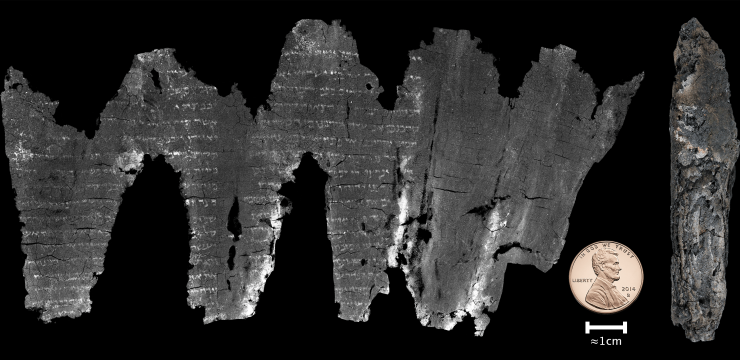
Science Blender | Virtual Unwrapping Student Essay from the HON 389 Science Blender Course
October 25, 2016
Periodically, we publish essays from Professor Andrew Lyon‘s Honors 389 course “The Science Blender”, which is the basis for Schmid College’s Grand Challenges Initiative. In HON 389, students are asked to reflect on different aspects of tackling a grand challenge. In this essay, student’s were asked to research and analyze an interdisciplinary breakthrough of their choosing.
A recent breakthrough in science has offered the possibility of deciphering ancient manuscripts that have been damaged or are just too fragile to touch. Many different disciplines have come together to make this process possible, including: archaeology, computer science, and X-ray technology.
Over the centuries, countless ancient texts have been discovered by archaeologists all over the world. Many of these texts were illegible from the damage they had received over the years. The damaged texts, usually written on an animal skin called parchment, were locked away to preserve their fragile remains with the hopes that someday they could be reprieved of enough damage be studied.
Recently, a means of viewing the deteriorated content was used on En-Gedi, one of the Dead Sea Scrolls, that was charred to a crisp in a fire over 1,400 years ago [1, 2]. The process, called virtual unwrapping, yielded incredible images and resulted in a decodable document with a view of the interior written language.
Previous experiments using virtual unwrapping had employed only pieces of text and were not believed to be capable of reproducing the process on a full document [3]. These smaller experiments still offered legible text at the end of the process.
The procedure begins with a three-dimensional X-ray scan of the deteriorated text that can be viewed on a computer [4]. The digital manuscript is then inspected for denser spots, which would indicate a presence of metallic ink [4]. Segmentation is the next part of the process. Here the digital roll of parchment is split into smaller sections of the scroll [4]. The smaller sections of the scroll are then textured to increase the readability of the text [4]. From there the sections are digitally flattened and pieced back together to present a digital copy of the damaged scroll [4].
The virtual unwrapping of En-Gedi has shown that this process works even on severely fire damaged writings. En-Gedi has been discovered to be a piece of the Hebrew Bible from the Book of Leviticus [1].
“The scientists now hope to read other ancient artifacts that have been damaged in the course of history” [2]. Many more discoveries can be made with the help of virtual unwrapping.
Virtual unwrapping has opened a door to vast amounts knowledge about the past that had seemed lost to the world. Fragile texts can now be read and translated to reveal information that, for centuries, had been unknown. Virtual unwrapping is a monumental new interdisciplinary discovery that will be beneficial in the future.
References
[1] 1,700-Year-Old Dead Sea Scroll ‘Virtually Unwrapped,’ Revealing Text. (n.d.). Retrieved September 21, 2016, from http://www.livescience.com/56196-dead-sea-scroll-virtual-unwrapping.html
[2] Sample, I. (2016, September 21). Jubilation as scientists use ‘virtual unwrapping’ to read burnt ancient scroll. Retrieved September 21, 2016, from https://www.theguardian.com/science/2016/sep/21/jubilation-as-scientists-use-virtual-unwrapping-to-read-burnt-ancient-scroll
[3] =, B. (n.d.). Virtual unrolling and information recovery from scanned scrolled historical documents. Retrieved September 21, 2016, from http://www.sciencedirect.com/science/article/pii/S0031320313002677
[4] William Brent Seales1,*, Clifford Seth Parker1, Michael Segal2, Emanuel Tov2, Pnina Shor3 and Yosef Porath31Department of Computer Science, University of Kentucky, Lexington, KY 40506, USA.2Hebrew University of Jerusalem, Jerusalem, Israel.3Israel Antiquities Authority, Jerusalem, Israel.↵*Corresponding author. Email: seales{at}uky.edu, By William Brent Seales, Clifford Seth Parker, Michael Segal, Emanuel Tov, Pnina Shor, Yosef Porath, & Science Advances21 Sep 2016 : e1601247. (n.d.). From damage to discovery via virtual unwrapping: Reading the scroll from En-Gedi. Retrieved September 21, 2016, from http://advances.sciencemag.org/content/2/9/e1601247.full

